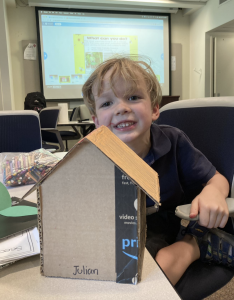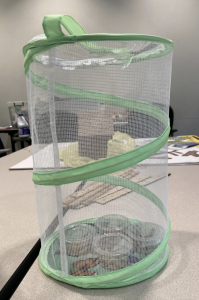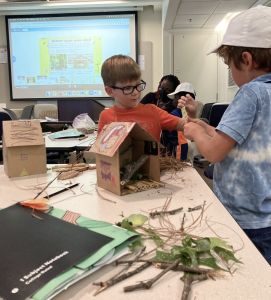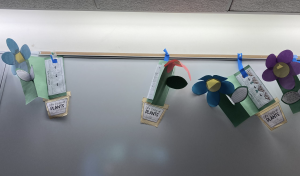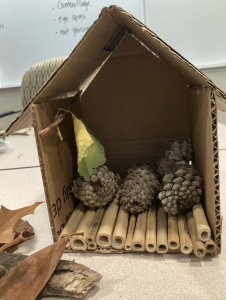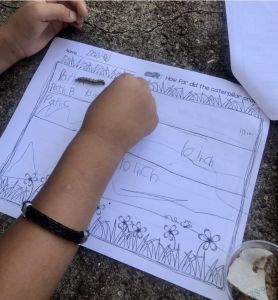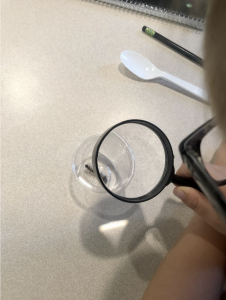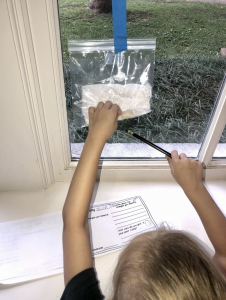Summer SAVY 2022/Session 6 – Agricultural Engineering for Rising 1st/2nd Grade
Friday:
Thank you for allowing your students to spend an amazing week in Agriculture Engineering. The students documented their seeds sprouting and a lot of their caterpillars have moved to the second life stage pupa/chrysalis. Students learned about the Engineering Design Process to learn how Agricultural engineers solve problems. We finished the book Mariana Becomes a Butterfly. In the book Mariana had a pollination problem with her Ohelo plant. The students started thinking like an agricultural engineer and developed hand pollinators for the Poppy, Dutchman’s Pipe, Bucket Orchid, and the Jack-in-the Pulpit plant using the Engineering Design Process. Students identified the properties of materials to determine the best material to use for their hand pollinators. Students planned, designed, and created their hand pollinators. Then the students tested their hand pollinators by picking up “pollen” (baking soda) and pollinating their flowers. Virtually students explored hand pollinators used in the real-world. Students learned about the male and female parts of a plants. Discussed seed dispersal and the methods in which seeds are dispersed. Students created explosive seed pods to be exploded at home. Students will also be bringing home a Painted Lady caterpillar to continue to observe the Butterfly Life Cycle. Once the caterpillars have reached the adult stage they will release the butterflies to allow them to pollinate our world.
Thursday: Today in Agricultural Engineering students began with documenting the changes with their seeds and caterpillars. Students learned about the anatomy and contributions of bees. Discovered new technologies developed from the study of insects. Continued reading Mariana Becomes a Butterfly. Discussed the misconceptions about insects. Learned about Integrated Pest Management(IPM) system. Integrated technology by virtually visiting an apple orchard, played a game to evaluate their knowledge of bees, caterpillars, and pollination, then played interactive pest and insect games. Students created finger puppets to perform the Honeybrook Apple Orchard play. Discovered the problem in each season of the play. Carefully analyzed the Integrated Pest Management solution the agricultural engineer created to solve each seasons problem. Students then created four paths for their caterpillar to follow. Each path was measured. Students went outside estimated the length their caterpillars would travel, then allowed their caterpillars to follow the paths for 30 seconds and measured the distance. Tonight ask the students about Integrated Pest Management systems and allow the students to find the perfect area outside for the Insect Homes they will be bringing home today.
Wednesday: Today we had a magnificent day in Agricultural Engineering! Students learned about caterpillars and other insects that help our environment. Each student received a caterpillar and created small habitats for the caterpillar. Students observed their seeds and documented its development. We visited the Stevenson Center II to observe the structure of seven temperature controlled greenhouses on Vanderbilts Campus. We continued reading the book Mariana Becomes a Butterfly. Students went on a nature walk to collect natural material to build their Bug Apartments. Students built Bug Apartments to provide shelter for insects. Students read about about Bees and Pollination. Tonight ask students “why are insects so important?”
Tuesday: In Agricultural Engineering today we started reading Mariana Become a Butterfly. The setting of the story takes place in Dominican Republic. The students took a virtual field trip to the Dominican Republic to learn about the environment, population, language, food and landmarks. The students virtually toured a greenhouse. Students learned about the metamorphosis of butterflies and how butterflies help agriculture. Created a butterfly booklet. Student’s learned about a butterflies compound eyes and did an activity using a Kaleidoscope to view objects as a butterfly views them. Our class caterpillars were delivered this afternoon and tomorrow the students will observe and identify the parts of the caterpillars.
Monday: We had a wonderful first day in Agricultural Engineering! The students learned what an agricultural engineer is and how we all benefit from the work that they do. Students learned all about plants. Students completed a flower foldable. Students dissected a seed and identified the seed parts. This week they will observe the seed they planned. Learned all about chlorophyll. Then students went outside to find leaves with the most chlorophyll to complete a chlorophyll rubbing. In the computer lab today students learned what it takes to grow crops with agricultural games. Tonight ask the students what an agricultural engineer does.

